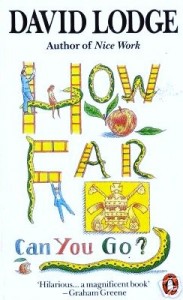 Until recently, for me, David Lodge was the academic who wrote great books of literary criticism, among which my all time favourite remains The Art of Fiction (1992), a collection of essays about authors, books, and how they both work together for our reading pleasure. Things changed when I started reading How Far Can You Go? (1980) and realized that not only does Lodge write about literary fiction, he also writes literary fiction.
Until recently, for me, David Lodge was the academic who wrote great books of literary criticism, among which my all time favourite remains The Art of Fiction (1992), a collection of essays about authors, books, and how they both work together for our reading pleasure. Things changed when I started reading How Far Can You Go? (1980) and realized that not only does Lodge write about literary fiction, he also writes literary fiction.
From reasons that I can’t really understand, but probably having to do with book marketing, in the USA, How Far Can You Go? was published as Souls and Bodies, a good enough title choice, but still not as representative as the British edition. The book also won the Whitbread Book of the Year award in 1980 and was published in paperback by Penguin Books in 1981.
The brilliant Penguin Books book cover depicts a game of snakes and ladders played by men and women which stands for the life English Catholics had to live in the 1950s and 1960s in order to remain true to their own religion: “Up there was Heaven; down there was Hell. The name of the game was Salvation, the object to get to Heaven and avoid Hell. It was like Snakes and Ladders: sin sent you plummeting down towards the Pit; the sacraments, good deeds, acts of self-mortification, enabled you to climb back towards the light. Everything you did or thought was subject to spiritual accounting.”
It is by this creed that the characters that open the book, Polly, Dennis, Angela, Adrian, Ruth, Miles, Violet, Michael, Edward, and Father Brierley lived for the most part of their lives. But, the restriction put on them by the Catholic Church robbed them of their freedom to enjoy their sexual life. Priests preached that sexual intercourse before the marriage, the use of contraception pills, and even enjoying your intimacy with your spouse were certain ways to go down the ladder to Hell.
Thus, the question in the title is one of sexual morality, referring to how far could you go with the opposite sex. The priests’ “answer was always the same, though expressed in different ways: your conscience would tell you, no further than you wouldn’t be ashamed to tell your mother, as far as you would let another boy go with your sister.” It is then no wonder that all men wanted to do is marry their college girlfriends and consummate the union. Little did they know that the consequences of their actions would bring about numerous unwanted babies and a life struggling to provide for them.
So, the novel follows the ups and down of all these characters up to the late 1970s when, in 1968, changes in the Catholic Church had them reassess the way they lived their life. When fear of Hell and the Pill no longer governed their lives, the characters stray away from their former beliefs and become advents of Catholic for an Open Church, a more relaxed variation of the traditional Catholic Church.
How Far Can You Go? by David Lodge reads both as a satire and a dark novel with frequent interruptions on the author’s part, which could be easily collected in a booklet of essays about the (English) Catholic Church. Adolescence, marriage, adultery, self-discovery and death are just a few of the themes that the novel touches upon. Although I’m not sure how popular the book is today, I highly recommend it to any Catholic (young or old) who would like to see the good, the bad, and the ugly of their own religion.
